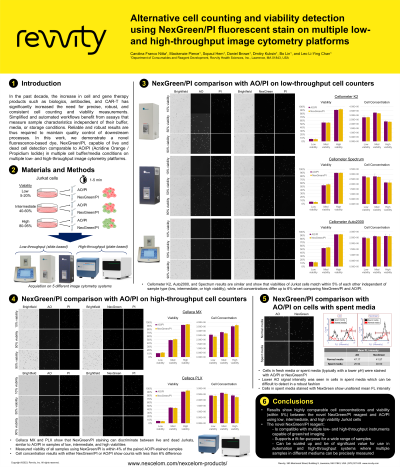Screening Applications & Diagnostics
Poster Session B
(1039-B) Alternative cell counting and viability detection using NexGreen/PI fluorescent stain on multiple low- and high-throughput image cytometry platforms
Wednesday, May 29, 2024
10:30 - 11:15 CEST
Location: Exhibit Hall

- RH
Reynald Hurteaux
Senior Product Specialist
Revvity Health Sciences, Inc.
Lawrence, MA, United States
Poster Presenter(s)
Abstract: In the past decade, the increase in cell and gene therapy products such as biologics, antibodies, and CAR-T has significantly increased the need for precise, robust, and consistent cell counting and viability measurements. Simplified and automated workflows benefit from assays that measure sample characteristics independent of their buffer, media, or storage conditions. Reliable and robust results are thus required to maintain quality control of downstream processes. In this work, we demonstrate a novel fluorescence-based dye, NexGreen/PI, capable of live and dead cell detection comparable to AO/PI in multiple cell buffer/media conditions. Jurkat cells of different viabilities (low, intermediate, and high) were stained in parallel with either NexGreen/PI or AO/PI for 1-2 minutes and measured on multiple image cytometer platforms including low-throughput (Cellometer K2, Auto2000, and Spectrum) and high-throughput (Cellaca MX and PLX) instruments. Both NexGreen/PI and AO/PI dyes are used as equal volumes added to cell samples (ex: 20 uL cells + 20 uL dye). Additionally, we tested if difficult to analyze cells in “spent” media (typically with a lower pH) or in PBS can be stained using NexGreen/PI compared to AO/PI. Results on the Cellaca MX and PLX show that NexGreen/PI staining can discriminate between live and dead Jurkats, similar to AO/PI in samples of low (10-20%), intermediate (40-60%), and high (80-95%) viabilities. Measured viability of all samples using NexGreen/PI was within 4% of the paired AO/PI-stained samples. Cell concentration results with either NexGreen/PI or AO/PI also show counts with less than 6% difference. Cellometer K2, Auto2000, and Spectrum results are similar and show that viabilities of Jurkat cells match within 5% of each other independent of sample (low, intermediate, or high viability), while cell concentrations differ up to 6% when comparing NexGreen/PI and AO/PI. Cells in “spent” media or washed and resuspended in PBS can exhibit low AO signal intensity that can be difficult to detect in a robust fashion. NexGreen/PI-stained cells, however, showed an unaltered fluorescence signal in these “tricky” cell samples. In this work, we demonstrated the capability of NexGreen/PI to measure cell counts and viability using low- and high-throughput instruments, which enables fit-for-purpose for a wide range of samples. Thus, our experiments demonstrate that NexGreen/PI is scalable and can be of significant value for use in automation and high-throughput systems where multiple samples in different mediums can be precisely measured.
